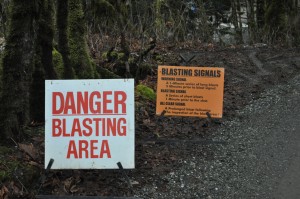Safety Is Everyone’s Responsibility
Safety is of paramount importance. The goal of every blast plan is to coordinate a quality controlled blast that will achieve the desired results needed for the job while protecting people, property and the environment. If you ever find material marked “explosives” please do not handle the material and contact law enforcement or the fire department.
Safety, for professionals handling explosives and for the public around blasting projects, has improved over time to what it is today for reasons such as:
- A commitment to training and continuous improvement.
- A safety-first culture within the industry.
- Ongoing development of safer explosives products.
- Past experience and research that help shape regulations and laws.
- Clear communications of blasting safety protocols to communities.
At blast time, a combination of warning signals, signs, barricades and guards will be used to secure the blasting area. Never enter a blast area without permission or an authorized escort. Sometimes local police or regulators help secure the blast area or redirect traffic. At the time of the blast, keep your distance according to the area communicated by company representatives. Blasting times are usually scheduled, but on occasion may be changed due to unforeseen circumstances. So be alert to the blast signals used at the job site. These procedures help ensure your safety and the safety of those conducting the work.
Signs are meant to help inform and protect the public. Some types of signs are:

- Storage magazine signs identify where explosives are stored and serve as warning to fire fighting professionals.
- Perimeter signs typically identify project boundaries.
- Blast area signs inform the public of where blasting may be occurring within the project area.
- Entry point signs may specify blast warning signals.
- Transportation vehicle signs inform first responders of the vehicle’s contents.
Please comply with any signage and maintain your distances as posted. If you see unauthorized people entering signed areas, please call the local police. In the event you see a fire at or near explosives storage, keep away and call the fire department. Never attempt to fight an explosives fire.
Explosives transportation on public roads is regulated and controlled.
- Drivers are trained in proper shipment and handling of explosives.
- Travel routes are usually designated to facilitate the safest route.
- Vehicles are properly placarded regarding their contents.
In the event of an accident, contact local emergency response personnel and stay clear of the area.
When blasting near homes, precautions associated with the job site will be communicated to the public. This communication may include dates and times of blasting and the blast warning signals. Notifications may be provided:
- In person: This will provide you with an opportunity to ask questions and request contact information.
- In the mail: If you receive a notice of blasting in the mail, read the entire mailing and make note of pertinent information.
- On your door: If you receive a notice of blasting on your door, read the entire notice and make note of pertinent information.
- At public meetings or in public notices.
If questions remain, be sure to contact the company listed on the notice and ask specific questions to meet your concerns. The explosives industry relies on the cooperation of surrounding neighbors and the public at large to adhere to precautions communicated by blasting professionals to ensure safety.
